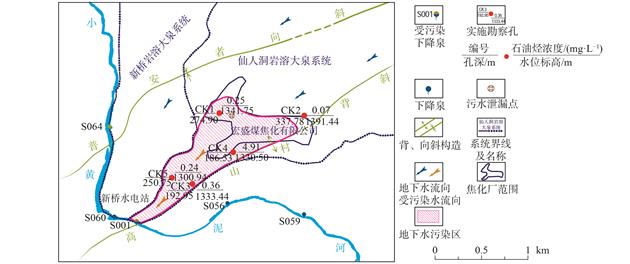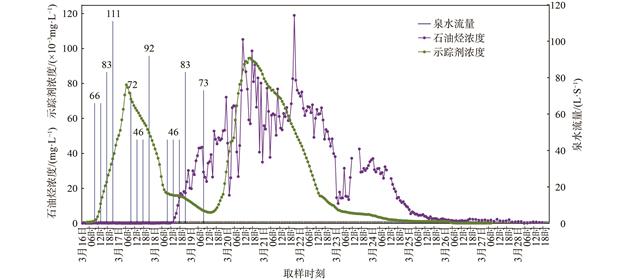| 岩溶断层区含油废水溢流地下水污染风险评价 |
| |
| 引用本文: | 宋建新, 黄磊, 吉勤克补子, 江峰, 焦恒. 岩溶断层区含油废水溢流地下水污染风险评价[J]. 环境工程学报, 2023, 17(12): 3960-3968. doi: 10.12030/j.cjee.202307097 |
| |
| 作者姓名: | 宋建新 黄磊 吉勤克补子 江峰 焦恒 |
| |
| 作者单位: | 1.自然资源部国土整治中心,北京 100035;; 2.桂林理工大学,桂林 541004;; 3.中国科学院生态环境研究中心,中国科学院饮用水科学与技术重点实验室,北京 100085;; 4.贵州省地质矿产勘查开发局 114地质大队,遵义 563000;; 5.贵州省地矿局第二工程勘察院有限公司,遵义 563000 |
| |
| 基金项目: | 国家重点研发计划资助(2022YFC3201705);南方石山地区矿山地质环境修复工程技术创新中心开放课题(NFSS2023003) |
| |
| 摘 要: | 
岩溶地下水是西南岩溶地区重要的生活和生产用水来源,由于其赋存地质环境复杂,受到污染后极难治理。以某含油废水溢流区为研究对象,通过调查污染区域的地质结构、溶洞通道及断层情况,评估污染物的来源、分布范围及主要迁移通道,构建基于地下水自净能力的地下水污染风险评价模型。
结果表明:研究区石油烃 (C10~C40) 、氰化物和甲苯污染严重,三者检出率分别为98.7%,75.3%和59.7%,包气带内仍存在大量的石油类污染物,其质量为14.07 t;岩溶断层区地下水系统存在2条岩溶通道,且石油类污染物主要通过第一条通道迁移;地下水中石油类污染物的自然衰减过程符合指数型衰减特征;人工冲洗情景下,污染物和示踪剂浓度下降速度加快,地下水自净能力显著提高;岩溶断层区地下水污染风险指数与泉流量之间呈现负相关关系。该研究成果可为岩溶断层区含油废水溢流地下水污染的自然衰减式治理和风险防控提供参考。

|
| 关 键 词: | 岩溶断层区 石油类污染 地下水 自净能力 污染风险 |
| 收稿时间: | 2023-07-26 |
|
| 点击此处可从《环境工程学报》浏览原始摘要信息 |
|
点击此处可从《环境工程学报》下载全文 |
|



